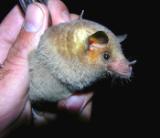An Endangered Bat with a Tequila Connection by Jess Lucas
If you still find you can't see bats in a positive light, consider this. Texas has a very special resident, the Mexican long-nosed bat, without which there would be no tequila.
The Mexican long-nosed bat (Leptonycteris nivalis) makes a seasonal foraging trek to west Texas every year, migrating north from Mexico. While most bats found in Texas are insectivorous (insect-eating), this bat is specially built to consume nectar and pollen, primarily from the flowers of the agave. You may already know that tequila is made using agave plants, but you likely didn't know bats have made it all possible.
The migration of the Mexican long-nosed bat appears to follow the range of the agave plant and the progression of the plants as they flower. The agave opens its flowers at night, and attracts the bats with large amounts of nectar. When the bats are feeding on the nectar and pollen, they pick up some pollen on their fur and faces, and transfer the pollen on to the next plant they visit, cross-fertilizing the agave. The bats and the agave are mutually dependent - the bats need the food, the plants need to reproduce. Likewise, the tequila industry benefits from the genetic diversity of the agave plants, which helps build resistance to disease and pests.
However, this relationship is in danger. In parts of the bats' range (primarily in Mexico and Central America) wherever bat roosts are found, entire colonies (usually containing multiple species) have been deliberately poisoned and roosts have been vandalized, primarily because of social stigmas regarding bats. In Latin America, vampire bats are considered harmful to livestock and stigmatized as being "evil", and all bats seem to get the same treatment. Unfortunately, Mexican long-nosed bats were hard hit by the blanket exterminations.
Additionally, the range-wide source of the agave plants on which the bats depend has also been decimated, and the continuous migration and foraging route of the bats now has gaps. In many cases, the loss of agave plants can be attributed to the production of regional bootleg liquor. To make the liquor, the plant is "beheaded" - the center of the plant (the part that will form a flower stalk) is cut out, and when the plant base is deemed ripe it is trimmed and cut off the ground. This cone-looking part of the plant is full of fluids used to produce liquor. Unfortunately, flowering is a rare event in agaves, with some species gaining the name "century plant" for the time it takes them to bloom. Additionally, each plant only blooms once, and then the agave dies. When agaves are cut before blooming, a loss of genetic diversity for the agave species occurs - as does a loss of feeding opportunity for bats.
These two major issues led to the addition of the Mexican long-nosed bat to the U.S. Fish and Wildlife Service Endangered Species list in 1988. Incidentally, the species is now protected wherever found in the U.S., and additionally, Mexico has afforded it similar protection.
Fortunately, over the past 20 years, educational efforts by bat conservation groups have helped turn public opinion on bats, and conservation efforts have begun on the Mexican side of the border, improving the situation. Frequent population counts on the species have shown the situation is less dire than it was in the past.
The Mexican long-nosed bat is a part-time resident of west Texas, where it has been captured by researchers in Brewster and Presidio counties. It is known to roost in caves and mines, but there is only one known roost for the species in the United States, and that is within Big Bend National Park. This colony varies in size, but up to 10,650 individuals have located to the cave seasonally.
If you live in the Trans Pecos, you can help support the Mexican long-nosed bat in a couple of ways. Locate a reputable source for local agave plants, and find a place in your garden for them. It will take years for the agave to bloom, but they provide nice greenery in the meantime. When the flower stalk does appear, it will provide food for bats, moths, and many other species.
If you don't have space for an agave plant, or desire a quicker turnaround, you can hang out a hummingbird feeder or two, and there's a chance the bats may visit the feeders for a quick snack at night.
Jess Lucas is a former Texas Parks and Wildlife Department non-game data specialist working with the Bat Working Group out of the Austin headquarters office.





